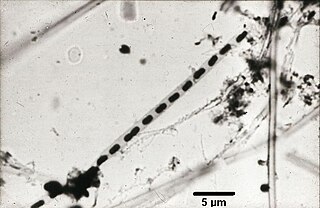Related Research Articles

The Comamonadaceae are a family of the Betaproteobacteria. Like all Pseudomonadota, they are Gram-negative. They are aerobic and most of the species are motile via flagella. The cells are curved rod-shaped.

The Pasteurellaceae comprise a large family of Gram-negative bacteria. Most members live as commensals on mucosal surfaces of birds and mammals, especially in the upper respiratory tract. Pasteurellaceae are typically rod-shaped, and are a notable group of facultative anaerobes. Their biochemical characteristics can be distinguished from the related Enterobacteriaceae by the presence of oxidase, and from most other similar bacteria by the absence of flagella.
Marinifilum is a genus of bacteria from the family of Marinifilaceae.
Desulforhopalus is a Gram-negative, strictly anaerobic, and non-motile genus of bacteria from the family of Desulfobulbaceae.
Aminiphilus is a Gram-negative, non-spore-forming and motile genus of bacteria from the family of Synergistaceae with one known species. Aminiphilus circumscriptus has been isolated from anaerobic sludge from Colombia.
Thermanaerovibrio is a Gram-negative, non-spore-forming chemoorganotrophic and thermophilic genus of bacteria from the family of Synergistaceae.
Cloacibacillus is a Gram-negative and anaerobic genus of bacteria from the family of Synergistaceae. Cloacibacillus bacteria are pathogenic.
Aminobacterium is a Gram-negative genus of bacteria from the family of Synergistaceae.
Pyramidobacter is a gram-negative genus of bacteria from the family of Synergistaceae. Pyramidobacter piscolens has been isolated from the human mouth.
Nautilia is a genus of bacteria from the family of Synergistaceae.
Nitratifractor is a genus of bacteria from the order Campylobacterales, with one known species.
Natranaerobius is a halophilic and anaerobic genus of bacteria from the family of Natranaerobiaceae.
Paraglaciecola is a genus of bacteria from the family Alteromonadaceae.
Niabella is a genus of bacteria from the family of Chitinophagaceae.
Taibaiella is a genus of bacteria from the family of Chitinophagaceae.
Rheinheimera is a genus of bacteria from the family of Chromatiaceae. Rheinheimera is named after the German microbiologist Gerhard Rheinheimer.
Breznakia blatticola is a Gram-positive and obligately anaerobic bacterium from the genus of Breznakia which has been isolated from the hindgut of the cockroach Shelfordella lateralis in Germany.
Breznakia pachnodae is a Gram-positive and obligately anaerobic bacterium from the genus of Breznakia which has been isolated from the gut of the insect larva Pachnoda ephippiata in Germany.
Halobacteroides is a Gram-negative strictly anaerobic, chemoorganotrophic genus of bacteria from the family of Halobacteroidaceae.
Oleiharenicola is a genus of bacteria from the family of Opitutaceae.
References
- 1 2 "Breznakia". LPSN .
- ↑ "Breznakia". www.uniprot.org.
- ↑ Parker, Charles Thomas; Garrity, George M (7 October 2016). Parker, Charles Thomas; Garrity, George M (eds.). "Taxonomic Abstract for the genera". NamesforLife, LLC. doi:10.1601/tx.29415.
{{cite journal}}: Cite journal requires|journal=(help)